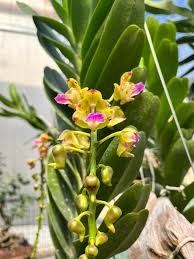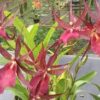# Creating the Ideal Living Environment for Quế Lan Hương Orchids

Quế Lan Hương orchids, also known as *Dendrobium anosmum*, are cherished for their exquisite beauty and captivating fragrance. These tropical orchids are native to Southeast Asia and thrive in specific environmental conditions that mimic their natural habitats. If you want to cultivate healthy Quế Lan Hương orchids that bloom beautifully, creating the ideal living environment is essential. This comprehensive guide will explore the necessary conditions, including light, temperature, humidity, watering, potting, and fertilization, to help you successfully grow and maintain these stunning plants.
## 1. Understanding the Natural Habitat of Quế Lan Hương Orchids
Before delving into how to create the ideal environment for Quế Lan Hương orchids, it’s vital to understand their natural habitat. These orchids typically grow in the tropical and subtropical regions of Southeast Asia, often found as epiphytes on trees or as lithophytes on rocks. In these environments, they receive dappled sunlight filtered through the canopy, high humidity levels, and warm temperatures.
### 1.1 Key Characteristics of Their Natural Habitat
– **Light**: In their natural setting, Quế Lan Hương orchids receive bright, indirect light. Direct sunlight can scorch their leaves, while too little light can hinder their growth and flowering.
– **Temperature**: These orchids thrive in warm temperatures, generally between 70°F and 85°F (21°C to 29°C) during the day and slightly cooler at night. They can tolerate short periods of cooler temperatures but prefer a stable warm environment.
– **Humidity**: Quế Lan Hương orchids flourish in high humidity, often exceeding 50% and sometimes reaching up to 80% during the rainy season.
– **Watering**: In their natural habitat, these orchids experience alternating wet and dry conditions. This means they require thorough watering during the growing season but must also be allowed to dry out between waterings to prevent root rot.
– **Air Circulation**: Good air circulation is essential for preventing fungal infections and promoting healthy growth. In the wild, these orchids benefit from the natural airflow provided by their surroundings.
## 2. Light Requirements
### 2.1 Providing Adequate Light
To create an ideal living environment for your Quế Lan Hương orchids, ensuring they receive the right amount of light is crucial:
– **Location**: Place your orchids near east-facing windows, where they can receive bright, indirect light in the morning. Avoid south-facing windows, as they can expose the plants to intense, direct sunlight that may damage the leaves.
– **Supplemental Lighting**: If natural light is insufficient, consider using grow lights. Full-spectrum LED or fluorescent lights can provide the necessary light spectrum for optimal growth. Position the lights about 12-18 inches above the orchids, ensuring they receive 12-14 hours of light daily.
### 2.2 Monitoring Light Conditions
Keep an eye on your orchids’ response to light. Signs of too much light include yellowing leaves or sunburned spots, while too little light can result in leggy growth and poor flowering. Adjust the position of your orchids or the intensity of the supplemental lighting as needed.
## 3. Temperature Control
### 3.1 Maintaining Ideal Temperatures
Quế Lan Hương orchids prefer warm temperatures, and maintaining the right temperature range is essential for their health:
– **Daytime Temperature**: Aim to keep the daytime temperature between 75°F and 85°F (24°C to 29°C). If temperatures exceed 85°F, ensure proper ventilation and humidity to prevent heat stress.
– **Nighttime Temperature**: Allow nighttime temperatures to drop slightly, ideally between 60°F and 70°F (15°C to 21°C). This temperature variation can encourage flowering.
### 3.2 Strategies for Temperature Control
– **Heating and Cooling**: If you live in a region with extreme temperatures, consider using heaters or air conditioners to regulate the climate. A thermostat can help maintain consistent temperatures.
– **Placement**: Position your orchids away from drafts, air conditioning vents, and direct heat sources. A stable environment will promote healthy growth.
## 4. Humidity Management
### 4.1 Creating Humidity Levels
High humidity is vital for the health of Quế Lan Hương orchids. Here are some effective strategies to maintain optimal humidity levels:
– **Humidity Levels**: Aim for humidity levels between 50% and 80%. A humidity gauge can help you monitor the environment accurately.
– **Misting**: Lightly mist your orchids with water regularly, especially during dry seasons. However, avoid over-misting, as excessive moisture can lead to fungal issues.
### 4.2 Humidity-Boosting Techniques
– **Humidity Trays**: Place a shallow tray filled with pebbles and water beneath your orchids. As the water evaporates, it will increase humidity around the plants.
– **Group Plants**: Grouping your orchids together can create a microclimate with higher humidity levels. The combined transpiration from multiple plants will help maintain moisture.
– **Humidifiers**: If your home is particularly dry, consider using a humidifier to maintain consistent humidity levels.
## 5. Watering Practices
### 5.1 Establishing a Watering Schedule
Watering is a critical aspect of orchid care. Here are some guidelines for proper watering:
– **Watering Frequency**: Quế Lan Hương orchids generally require watering every 5-7 days during the growing season (spring and summer) and less frequently during the dormant period (fall and winter).
– **Check Moisture Levels**: Before watering, check the moisture level of the potting medium. The top inch should be dry before adding more water.
### 5.2 Water Quality
– **Use Distilled Water**: To avoid mineral buildup and potential harm to the orchids, use distilled or rainwater for watering. Tap water can contain chemicals and salts that may negatively affect your plants.
– **Watering Method**: Water your orchids thoroughly, ensuring that water drains out of the bottom of the pot. Avoid letting the orchids sit in standing water, as this can lead to root rot.
## 6. Potting and Growing Medium
### 6.1 Selecting the Right Potting Medium
Choosing an appropriate potting medium is essential for healthy root development:
– **Orchid Mix**: Use a specialized orchid potting mix, typically consisting of bark, sphagnum moss, and perlite. This mix promotes drainage and aeration, preventing root rot.
– **Repotting**: Repot your Quế Lan Hương orchids every 1-2 years to refresh the potting medium and provide adequate space for growth. Spring is the ideal time for repotting.
### 6.2 Pot Selection
– **Pot Type**: Use pots with drainage holes to allow excess water to escape. Clay pots can help absorb moisture and regulate temperature.
– **Pot Size**: Choose a pot that is slightly larger than the current one to accommodate root growth without allowing the medium to retain excessive moisture.
## 7. Fertilization Techniques
### 7.1 Understanding Nutritional Needs
Fertilization plays a crucial role in the overall health and blooming of Quế Lan Hương orchids:
– **Type of Fertilizer**: Use a balanced, water-soluble orchid fertilizer, preferably one with a higher nitrogen content during the growing season to promote leaf and stem growth.
– **Fertilizing Schedule**: Fertilize every 2-4 weeks during the growing season and reduce feeding during the dormant period.
### 7.2 Application Methods
– **Dilution**: Always dilute the fertilizer to half the recommended strength to prevent fertilizer burn.
– **Watering in**: Apply the fertilizer during regular watering, ensuring that it reaches the root zone.
## 8. Air Circulation
### 8.1 Importance of Airflow
Good air circulation is essential for preventing fungal infections and promoting healthy growth:
– **Placement**: Ensure your orchids are in a location with good airflow. Avoid placing them in closed or stagnant environments.
– **Fans**: Consider using small oscillating fans to improve air circulation, especially in humid conditions.
### 8.2 Monitoring Humidity and Temperature
– **Ventilation**: Ensure adequate ventilation in your growing space. Open windows and doors when possible to allow fresh air to circulate.
## 9. Seasonal Considerations
### 9.1 Adapting Care for Different Seasons
Understanding how seasonal changes impact your orchids is crucial for successful cultivation:
– **Spring and Summer**: During the growing season, provide ample light, humidity, and consistent watering. Fertilize regularly to support new growth.
– **Fall and Winter**: Reduce watering frequency as the orchids enter dormancy. Allow the medium to dry out between waterings and cut back on fertilization.
### 9.2 Recognizing Signs of Stress
Keep an eye on your orchids for any signs of stress, such as wilting, yellowing leaves, or lack of blooms. Adjust care routines as needed to meet their evolving needs throughout the seasons.
## 10. Conclusion
Creating the ideal living environment for Quế Lan Hương orchids requires attention to various factors, including light, temperature, humidity, watering, potting, and fertilization. By mimicking their natural habitat and providing the necessary care, you can enjoy the stunning beauty and fragrance of these tropical orchids.
As you embark on your orchid-growing journey, remember that patience and observation are key. Each orchid is unique, and understanding its specific needs will contribute to its overall health and vibrancy. With dedication and care, you can successfully cultivate Quế Lan Hương orchids and enjoy their enchanting presence in your home or garden for years to come.

